Australian Snakes
Not as dangerous as they make you believe
Australian snakes seem to be the scariest of all Australian Animals.
Everybody fears snakes in Australia. Not only travellers, but also most locals are absolutely terrified of snakes.
Yet there is no need to be scared. Lack of information, wrong information, hype and sensationalism have given the Australian snakes an image that they really don't deserve.
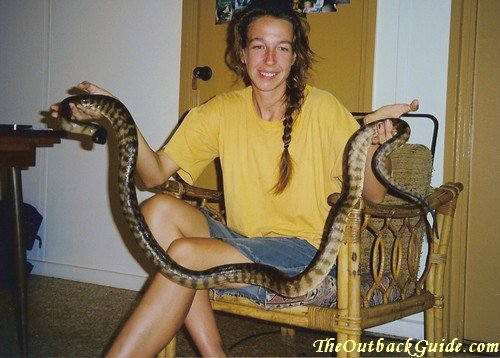
I want to dispel some of the myths about the Australian venomous snakes.
I don't expect to turn you into a snake lover like me, but I sure hope you will at least be able to travel through the Australian Outback and enjoy it, without needlessly worrying about poisonous Australian snakes.
Below you will find answers to the following questions:
- What should I do if I see a snake?
- How can I tell if a snake is venomous?
- How should a snake bite be treated?
Common Sense Goes A Long Way
In the 18 years I have lived, travelled and worked in the Australian Outback I have known three people who were bitten by snakes. Of course, like everybody else I heard many, many tales of snake bites. But only three Australian snake bites where I know the people, and I know what happened.
In the first case the person was on his way home from the pub, rather drunk, and of course he felt six feet tall and bulletproof. He picked up the snake to impress the girls walking with him. The snake was not impressed. Lucky for him it was a harmless python.
The second person was bitten as he was climbing a cliff at a swimming hole to jump off the ledge. The snake had been sun basking on the very same ledge and as he reached up without looking he grabbed it. Of course it was startled and bit. By the way, the man was drunk.
In this case it was one of the slightly more dangerous Australian snakes, what we call a King Brown here. Despite ignoring every rule on how to treat snake bites the man survived. And was seen drinking at the pub two days later.
(Read about how to treat snake bites - and what this man did wrong - here).
The last person was an experienced snake handler, and was bitten by his own Tiger snake. People who handle snakes a lot tend to become careless. In fact, many snake bites happen when people handle or try to kill snakes.
The Tiger snake is highly venomous indeed. The snake handler went to hospital, was treated with antivenin, and was fine.
Update: Since I first wrote the page I have become aware of two more snake bites because I happen to know a nurse at our local hospital. In both cases the men were drunk and in both cases they were bitten while trying to catch or kill the snake.
(I also know one of the victims through work, and nobody there was surprised the bloke got bitten. Let's just say he's not the sharpest tool in the shed. Showing off by picking up a Brown Snake while blind drunk, that's just what you'd expect him to do...)
Both times it was a Western Brown Snake, also known as Gwardar. This again is a highly venomous snake and the bite is indeed very dangerous. But again nobody came to harm. Both men ended up in hospital and received antivenin, and both recovered.
So where does the common sense come into it? Well, in four of the five scenarios it was not involved at all!
- Don't touch any snakes in Australia unless you know what you are dealing with and what you are doing.
- Look where you put your feet and your hands. Don't stumble around barefoot in long grass, don't reach into dark corners where a snake might be hiding, or anywhere you can't see.
- It's a good idea to wear solid shoes when bushwalking.
- If you need to walk outside at night use a torch.
- Snakes don't like or seek human company. If given a chance a snake will flee. Just give it a chance to flee.
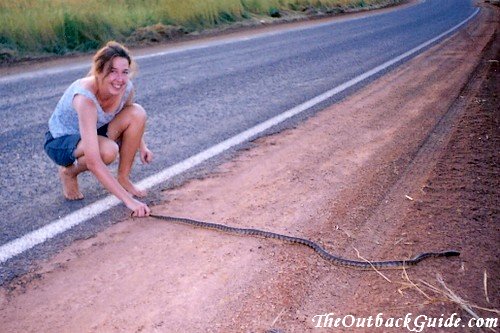
The photo shows me years ago on my very first encounter with an Australian snake. As you can see, I didn't heed my own advice. The snake by the way is a Black-headed Rock-python. On a different occasion I trod on a King Brown (Mulga snake), bare foot, in the dark. It didn't bite me, just took off. Now that is very lucky. Don't count on being lucky!
Do as I say, don't do as I do!
What Should I Do If I See A Snake?
What would you do if you saw any other Australian animal, say a dingo or kangaroo? My guess is most people would stand still, hope not to scare it off, and then inch a bit closer to take a good photo of it.
There is no reason to act differently when you see any Australian snake. In most cases the snake will very quickly disappear as soon as it senses you, just like the dingo or kangaroo will. So good luck with that photo.
Avoid anything that might threaten or scare the snake. If a snake feels cornered it will bite to defend itself. I would not recommend trying to corner a big male red kangaroo either! Any animal that feels threatened will defend itself as best as it can, not just Australian snakes.
Most snake bites happen when people try to catch or kill snakes.
(Read more about how dangerous Australian venomous snakes really are.)
But what if the snake is in the car, house, bathroom...?
If it was me, I'd first take a photo. Honest.
Here is a photo of the King Brown or Mulga Snake that lived in the wall of my house for several years:
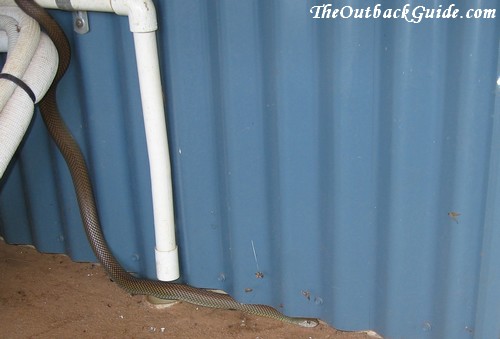
And this is a picture of a young Olive Python I had just found in my bedroom:
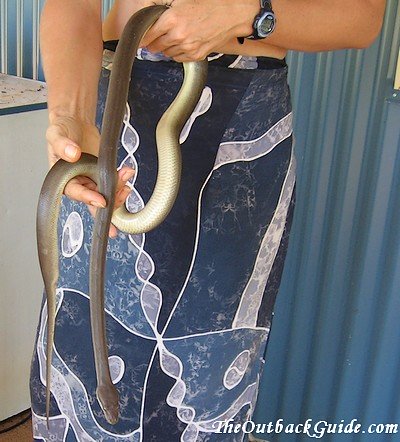
This photo shows my mum who was visiting from Germany. The snake is a Children's Python and we had found it behind the stove in the kitchen:
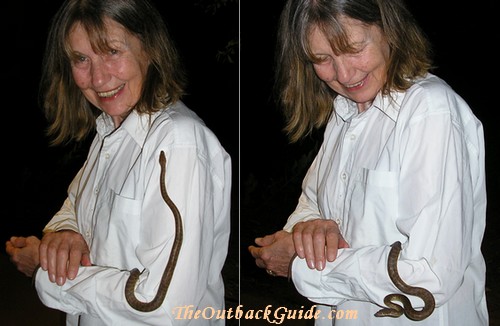
As you hopefully noticed, I only pick up the non-venomous snakes!
I live in the bush in a very hot part of Australia so I do find the occasional snake on my veranda or in my garden, and usually the snake sees me the moment I see the snake...
...and takes off!
(The snakes in the pictures were found on cold mornings or evenings, when these cold blooded animals can't move fast and are not aggressive at all. And of course all snakes were released where they were found after the photo shoot. Except for the one in the bedroom. I let that go in the garden.)
After that little intermezzo let's return to the question at hand: what should YOU do when you find a snake in Australia?
In the highly unlikely event that you see a snake inside make sure you give it an opportunity to escape and then go and get help. Someone will know who to call to remove the snake. Don't panic. It won't attack you. Australian snakes just don't do that. Unless you give them a reason to. See above.
How Can I tell If A Snake Is Venomous?
You usually can't. The only way to tell if a snake is venomous is to identify the snake. There are no general rules, and names are as misleading as snake photographs.
Any Brown Snake, Western Brown or King Brown can be olive, greenish, gray, copper or golden coloured. Many a harmless python has been killed for being brownish in colour. Other harmless Australian snakes died for being mottled or stripy. Not every striped snake is a Tiger Snake!
Juveniles can look very different from adult snakes. Size is no indicator at all. They're all small when they hatch.
Don't think small Australian snakes are harmless! A grown snake can control its venom and most times will only inflict a warning bite without injecting venom. This is not always true of a juvenile snake.
I call pythons harmless as they aren't venomous, but they still bite when annoyed. These bites can cause nasty infections and give you more trouble than a bite from a venomous snake.
Get a good Australian snake book (or DVD) if you really want to learn more about Australian snakes, look at pictures on this snake site, and at more Australian snakes here.
Visit wildlife parks. Take a good look at the snakes you see - if you can do so safely - and look at the number, size and the shape of the scales, particularly on the head. Compare it with your book. Ask someone who knows.
The more snakes you see the easier it gets to spot the differences and characteristics. That's how I learned about Australian snakes.
But until you can identify them without doubt simply treat all Australian snakes with respect and common sense.
How Should A Snake Bite Be Treated?
If you follow the advice above about Australian snakes you will never need this information. But it is natural to be curious. I also thought you might feel safer armed with this knowledge.
Snake venom does not move in the bloodstream as many people assume. It moves in tiny lymphatic vessels under the skin. This means it is comparatively easy to restrict its movement and to delay onset of symptoms for many hours.
Bites by Australian snakes should be treated like bites by any other snake.
A pressure immobilisation bandage should be applied immediately. It will apply pressure over a wide area of the bitten limb. Bandage the limb about as firmly as you would a sprained ankle. An elastic bandage is ideal for this. Do not cut off the blood flow!
Place the bandage over the bite and wrap the limb, first away from the heart, then back towards the heart. The finished bandage should reach from just above the fingers or toes as far up the limb as possible with the available materials.
The limb should be immobilised using a splint. The person should avoid any movement. If help is far away someone needs to go and get help. The person who got bitten must not attempt to walk!
- Do not wash the bite. Venom on the skin is needed to positively identify the snake and administer the correct antivenin.
- Do not cut bitten area.
- Do not suck venom out of wound.
- Do not use a constrictive bandage/tourniquet.
- Do not try to catch the snake.
Remember the man who was bitten by the King Brown snake while climbing the cliffs at the rock pool? First he chased, caught and killed the snake. Then he swam back across the rock pool. He and his friends did not treat the bite at all, instead they all walked back to the car together, a walk involving 170 rock steps! From there it was a 20 minute drive to the hospital.
By the time they arrived at the hospital his health was seriously affected, it took many weeks for him to fully recover. Correct initial treatment and behaviour probably would have avoided any symptoms altogether. Actually, it would have avoided the bite in the first place!
Well, as I said, he was back drinking at the pub two days later. Dumb luck. Don't you count on it!
So let's recap:
- You will be very lucky to even see a snake on your Australia visit.
- You'd have to be even more lucky to get a picture of it.
- Australian snakes are not aggressive. To get bitten is rarely a result of bad luck but usually a result of idiotic behaviour!
(Really! Read some interesting information about how dangerous Australian snakes really are.)
I'll say it again, as this is so important.
Simply treat all Australian snakes with respect and use some common sense!






